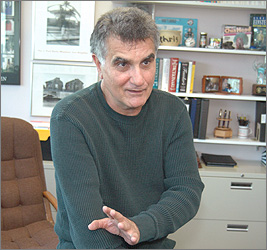There are probably few words that better represent
what American government stands for.
Saturday, Sept. 17, has been designated as “Constitution
Day” by the federal government. At
Cal State Fullerton, activities are planned to remind those
on our campus of the importance of this document and its ideals.
| Q: |
How did Constitution Day come about? Is this the first
year we’ve done anything highlighting the Constitution? |
| |
|
| A: |
Actually, there is a 91-year-old Republican activist who provides
tours at Independence Hall at Knott’s Berry Farm who has
been pushing this for years. She got the attention of U.S. Senator
Robert Byrd, who is well known for carrying a pocket-sized copy
of the Constitution with him. Senator Byrd pushed for a national
day to recognize the Constitution and once he started pushing,
it got on everybody’s radar. |
|
| Q: |
So what’s going to happen at Cal State Fullerton? |
| |
|
| A: |
One of the activities we’ll be sponsoring will take
place on Monday, Sept. 19, beginning at noon. We’re having
faculty members and students speak for about an hour in the
Quad. They’ll focus on different aspects of the Constitution,
why it’s important...and why it’s often misunderstood.
We hope to create a dialogue with those in attendance. Rather
than just standing around and saying “Three cheers for
the Constitution,” we wanted to create something more
meaningful. |
|
| Q: |
Do you find that many of your students aren’t
aware of what the Constitution means? |
| |
|
| A: |
No, not really. By the time someone arrives at a university,
they’re received several years of education — much
of their history and political science curriculum is focused
on the Constitution. I mean it’s the big enchilada of
U.S. politics. However, because people have been exposed to
the Constitution doesn’t mean they necessarily agree with
everything it says. |
|
| Q: |
What are some of the common misconceptions people
have? |
| |
|
| A: |
Well, here’s an example. I used to ask my students if
they believed the Constitution provided them with the right
as individuals to own guns. Many believed it did. But if you
read the second amendment, it says, “A well-regulated
militia, being necessary to the security of a free State, the
right of the people to keep and bear arms, shall not be infringed.”
In other words, you have a right as part of a militia in order
to secure the State to bear arms…not simply because you
want to. You can’t take sections out of context. It isn’t
always as cut and dried as people think. |
|
| Q: |
What about the first amendment? Are people familiar
with that? |
| |
|
| A: |
As a rule, yes. And in theory, most people claim to support
the First Amendment. After all, we’re all in favor of
free speech, freedom of religion and freedom of assembly. However,
when people are asked about specific instances such as, “Should
a communist have a right to make a speech?” people will
start saying, “No, no, no — we don’t want
that.” Well, the Constitution protects those rights. People
tend to look upon the Constitution as a symbol, not a document. |
|
| Q: |
What does this document say about us? |
| |
|
| A: |
Well, it has some very important principles, but it also has
some things that are quite disturbing. When it was originally
drafted, slavery was in effect and women didn’t have any
rights to speak of — so if you belonged to one of those
two groups, you weren’t represented. In many instances,
it was a racist, sexist document. However, it has evolved over
the years. We can trace the evolution of our country by the
changes that have occurred. |
|
| Q: |
So it’s important to try to figure out what
the intent of the framers was as opposed to what may actually
have been written, which reflected the customs and beliefs of
that time? |
| |
|
| A: |
Some believe you have to look at the intent of the framers.
It certainly reflected the customs and beliefs of the time.
Yet some believe otherwise. You have to apply a certain amount
of literary analysis when dealing with a document as important
as the Constitution. You also have to look at the meaning of
the words. I think you’ll be hearing much more about the
language of the Constitution during the upcoming weeks as the
selection of two Supreme Court justices is being carried out.
These are the individuals who are chosen to interpret the intent
of the Constitution and they will be dealing with what certain
language means or does not mean. |
